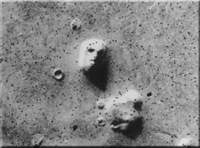There is no face on Mars, there is no life on Mars
The High Resolution Stereo Camera on the ESA’s Mars Express recorded new images of the so-called “Face on Mars” located in the Cydonia region in the Terra Arabia of the red planet. The massif became famous as the “Face on Mars” in a picture taken by the American Viking 1 Orbiter on July 25th, 1976. A NASA press release, issued several days later, said the formation resembled a human head. Could it be some kind of a message from the Martians?

The question was high on the agenda because the earthlings have repeatedly sent various pictures to space in an attempt to familiarize potential sentient beings with ways and images of humankind. The rock mounds around the mysterious face formation were interpreted as giant Martian pyramids resembling those in the ancient Egypt. Some scientists began to refer to the formation as a Martian sphinx. Imagination was running wild at the time.
Grandiose plans were drawn up one hundred years ago as scientists were certain that Mars was populated by sentient beings. Some plans involved sowing wheat in giant clearings that would have been cut in the Siberian woods. There were other plans for building canals in the Sahara, which would have been filled with oil and set on fire. The canals were supposed to illustrate Pythagoras’ theorem when observed from space. Eventually, scientific progress rendered those high-flown hopes totally deceptive. Mars formed some 4.6 billion years ago. The red planet had an excellent atmosphere. By and large, Mars was a sort of Eden among the other planets of the solar system. But its atmosphere was destroyed by continuous bombardment of asteroids and comets. Earth is 10 times larger than Mars. So Earth was saved by its size, so to speak.
Notwithstanding all the recent findings, optimists still refuse to believe that the formation in the Cydonia region is an optical illusion caused by the illumination angle of the Sun, the formation’s morphology and the resulting shadows. Ufologists kept clinging to their interpretations even after the first high-resolution images of the Cydonia region were recorded by NASA’s Mars Global Surveyor in 1998. The images clearly indicated the above natural factors contributing to the appearance of the rock mounds.
The resolution of the images recorded by ESA’s Mars Express is even higher; they allow a three-dimensional viewing. The dense fog and frequent dust storms over the area had prevented the orbiter from taking photos for two years. At last, scientists have a clear picture yet the myth will live on.
Izvestia Nauki
Translated by Guerman Grachev
Pravda.ru
Subscribe to Pravda.Ru Telegram channel, Facebook, RSS!




